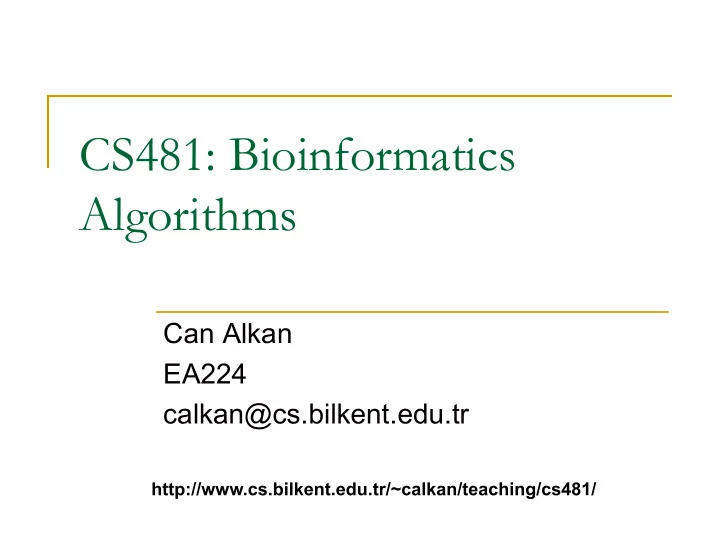

CS481: Bioinformatics Algorithms Can Alkan EA224 calkan@cs.bilkent.edu.tr http://www.cs.bilkent.edu.tr/~calkan/teaching/cs481/
Outline Codons Discovery of Split Genes Exons and Introns Splicing Open Reading Frames Codon Usage Splicing Signals TestCode
Gene Prediction: Computational Challenge Gene: A sequence of nucleotides coding for protein Gene Prediction Problem: Determine the beginning and end positions of genes in a genome
Gene Prediction: Computational Challenge aatgcatgcggctatgctaatgcatgcggctatgctaagctgggatccgatgacaatgcatgc ggctatgctaatgcatgcggctatgcaagctgggatccgatgactatgctaagctgggatccg atgacaatgcatgcggctatgctaatgaatggtcttgggatttaccttggaatgctaagctggga tccgatgacaatgcatgcggctatgctaatgaatggtcttgggatttaccttggaatatgctaatg catgcggctatgctaagctgggatccgatgacaatgcatgcggctatgctaatgcatgcggct atgcaagctgggatccgatgactatgctaagctgcggctatgctaatgcatgcggctatgctaa gctgggatccgatgacaatgcatgcggctatgctaatgcatgcggctatgcaagctgggatcc tgcggctatgctaatgaatggtcttgggatttaccttggaatgctaagctgggatccgatgacaa tgcatgcggctatgctaatgaatggtcttgggatttaccttggaatatgctaatgcatgcggctat gctaagctgggaatgcatgcggctatgctaagctgggatccgatgacaatgcatgcggctat gctaatgcatgcggctatgcaagctgggatccgatgactatgctaagctgcggctatgctaatg catgcggctatgctaagctcatgcggctatgctaagctgggaatgcatgcggctatgctaagct gggatccgatgacaatgcatgcggctatgctaatgcatgcggctatgcaagctgggatccgat gactatgctaagctgcggctatgctaatgcatgcggctatgctaagctcggctatgctaatgaat ggtcttgggatttaccttggaatgctaagctgggatccgatgacaatgcatgcggctatgctaat gaatggtcttgggatttaccttggaatatgctaatgcatgcggctatgctaagctgggaatgcat gcggctatgctaagctgggatccgatgacaatgcatgcggctatgctaatgcatgcggctatg caagctgggatccgatgactatgctaagctgcggctatgctaatgcatgcggctatgctaagct catgcgg
Gene Prediction: Computational Challenge aatgcatgcggctatgctaatgcatgcggctatgctaagctgggatccgatgacaatgcatgc ggctatgctaatgcatgcggctatgcaagctgggatccgatgactatgctaagctgggatccg atgacaatgcatgcggctatgctaatgaatggtcttgggatttaccttggaatgctaagctggga tccgatgacaatgcatgcggctatgctaatgaatggtcttgggatttaccttggaatatgctaatg catgcggctatgctaagctgggatccgatgacaatgcatgcggctatgctaatgcatgcggct atgcaagctgggatccgatgactatgctaagctgcggctatgctaatgcatgcggctatgctaa gctgggatccgatgacaatgcatgcggctatgctaatgcatgcggctatgcaagctgggatcc tgcggctatgctaatgaatggtcttgggatttaccttggaatgctaagctgggatccgatgacaa tgcatgcggctatgctaatgaatggtcttgggatttaccttggaatatgctaatgcatgcggctat gctaagctgggaatgcatgcggctatgctaagctgggatccgatgacaatgcatgcggctat gctaatgcatgcggctatgcaagctgggatccgatgactatgctaagctgcggctatgctaatg catgcggctatgctaagctcatgcggctatgctaagctgggaatgcatgcggctatgctaagct gggatccgatgacaatgcatgcggctatgctaatgcatgcggctatgcaagctgggatccgat gactatgctaagctgcggctatgctaatgcatgcggctatgctaagctcggctatgctaatgaat ggtcttgggatttaccttggaatgctaagctgggatccgatgacaatgcatgcggctatgctaat gaatggtcttgggatttaccttggaatatgctaatgcatgcggctatgctaagctgggaatgcat gcggctatgctaagctgggatccgatgacaatgcatgcggctatgctaatgcatgcggctatg caagctgggatccgatgactatgctaagctgcggctatgctaatgcatgcggctatgctaagct catgcgg
Gene Prediction: Computational Challenge aatgcatgcggctatgctaatgcatgcggctatgctaagctgggatccgatgacaatgcatgc ggctatgctaatgcatgcggctatgcaagctgggatccgatgactatgctaagctgggatccg atgacaatgcatgcggctatgctaatgaatggtcttgggatttaccttggaatgctaagctggga tccgatgacaatgcatgcggctatgctaatgaatggtcttgggatttaccttggaatatgctaatg catgcggctatgctaagctgggatccgatgacaatgcatgcggctatgctaatgcatgcggct atgcaagctgggatccgatgactatgctaagctgcggctatgctaatgcatgcggctatgctaa gctgggatccgatgacaatgcatgcggctatgctaatgcatgcggctatgcaagctgggatcc tgcggctatgctaatgaatggtcttgggatttaccttggaatgctaagctgggatccgatgacaa Gene! tgcatgcggctatgctaatgaatggtcttgggatttaccttggaatatgctaatgcatgcggctat gctaagctgggaatgcatgcggctatgctaagctgggatccgatgacaatgcatgcggctat gctaatgcatgcggctatgcaagctgggatccgatgactatgctaagctgcggctatgctaatg catgcggctatgctaagctcatgcggctatgctaagctgggaatgcatgcggctatgctaagct gggatccgatgacaatgcatgcggctatgctaatgcatgcggctatgcaagctgggatccgat gactatgctaagctgcggctatgctaatgcatgcggctatgctaagctcggctatgctaatgaat ggtcttgggatttaccttggaatgctaagctgggatccgatgacaatgcatgcggctatgctaat gaatggtcttgggatttaccttggaatatgctaatgcatgcggctatgctaagctgggaatgcat gcggctatgctaagctgggatccgatgacaatgcatgcggctatgctaatgcatgcggctatg caagctgggatccgatgactatgctaagctgcggctatgctaatgcatgcggctatgctaagct catgcgg
Central Dogma: DNA -> RNA -> Protein DNA CCTGAGCCA GAGCCAACT CTATTG TTGATGAA transcription CCU CCUGAGCC CCAACU CUAUUGAU GAUGAA RNA translation Protein PEPTIDE
Codons In 1961 Sydney Brenner and Francis Crick discovered frameshift mutations Systematically deleted nucleotides from DNA Single and double deletions dramatically altered protein product Effects of triple deletions were minor Conclusion: every triplet of nucleotides, each codon , codes for exactly one amino acid in a protein
The Sly Fox In the following string THE SLY FOX AND THE SHY DOG Delete 1, 2, and 3 nucleotides after the first ‘S’: THE SYF OXA NDT HES HYD OG THE SFO XAN DTH ESH YDO G THE SOX AND THE SHY DOG Which of the above makes the most sense?
Translating Nucleotides into Amino Acids Codon: 3 consecutive nucleotides 4 3 = 64 possible codons Genetic code is degenerative and redundant Includes start and stop codons An amino acid may be coded by more than one codon
Discovery of Split Genes “Adenovirus Amazes at Cold Spring Harbor” (1977, Nature 268) documented "mosaic molecules consisting of sequences complementary to several non-contiguous segments of the viral genome". In 1978 Walter Gilbert coined the term intron in the Nature paper “Why Genes in Pieces?”
Exons and introns In eukaryotes, the gene is a combination of coding segments ( exons ) that are interrupted by non-coding segments ( introns ) This makes computational gene prediction in eukaryotes even more difficult Prokaryotes don’t have introns - Genes in prokaryotes are continuous
Central Dogma and Splicing intron1 intron2 exon2 exon3 exon1 transcription splicing translation exon = coding intron = non-coding Batzoglou
Gene Structure
Splicing Signals Exons are interspersed with introns and typically flanked by GT and AG
Splice site detection Donor site 5’ 3’ Position % -8 … -2 -1 0 1 2 … 17 A 26 … 60 9 0 1 54 … 21 C 26 … 15 5 0 1 2 … 27 G 25 … 12 78 99 0 41 … 27 T 23 … 13 8 1 98 3 … 25 From lectures by Serafim Batzoglou (Stanford)
Consensus splice sites
Promoters Promoters are DNA segments upstream of transcripts that initiate transcription 5’ 3’ Promoter Promoter attracts RNA Polymerase to the transcription start site
Gene Prediction Analogy Newspaper written in unknown language Certain pages contain encoded message, say 99 letters on page 7, 30 on page 12 and 63 on page 15. How do you recognize the message? You could probably distinguish between the ads and the story (ads contain the “$” sign often) Statistics-based approach to Gene Prediction tries to make similar distinctions between exons and introns.
Statistical Approach: Metaphor in Unknown Language Noting the differing frequencies of symbols (e.g. ‘%’, ‘.’, ‘ - ’) and numerical symbols could you distinguish between a story and the stock report in a foreign newspaper?
Two Approaches to Gene Prediction Statistical: coding segments (exons) have typical sequences on either end and use different subwords than non-coding segments (introns). Similarity-based: many human genes are similar to genes in mice, chicken, or even bacteria. Therefore, already known mouse, chicken, and bacterial genes may help to find human genes.
Similarity-Based Approach: Metaphor in Different Languages If you could compare the day’s news in English, side -by-side to the same news in a foreign language, some similarities may become apparent
Genetic Code and Stop Codons UAA, UAG and UGA correspond to 3 Stop codons that (together with Start codon ATG) delineate Open Reading Frames
Six Frames in a DNA Sequence CTGCAGACGAAACCTCTTGATGTAGTTGGCCTGACACCGACAATAATGAAGACTACCGTCTTACTAACAC CTGCAGACGAAACCTCTTGATGTAGTTGGCCTGACACCGACAATAATGAAGACTACCGTCTTACTAACAC CTGCAGACGAAACCTCTTGATGTAGTTGGCCTGACACCGACAATAATGAAGACTACCGTCTTACTAACAC CTGCAGACGAAACCTCTTGATGTAGTTGGCCTGACACCGACAATAATGAAGACTACCGTCTTACTAACAC GACGTCTGCTTTGGAGAACTACATCAACCGGACTGTGGCTGTTATTACTTCTGATGGCAGAATGATTGTG GACGTCTGCTTTGGAGAACTACATCAACCGGACTGTGGCTGTTATTACTTCTGATGGCAGAATGATTGTG GACGTCTGCTTTGGAGAACTACATCAACCGGACTGTGGCTGTTATTACTTCTGATGGCAGAATGATTGTG GACGTCTGCTTTGGAGAACTACATCAACCGGACTGTGGCTGTTATTACTTCTGATGGCAGAATGATTGTG stop codons – TAA, TAG, TGA start codons - ATG
Open Reading Frames (ORFs) Detect potential coding regions by looking at ORFs A genome of length n is comprised of (n/3) codons Stop codons break genome into segments between consecutive Stop codons The subsegments of these that start from the Start codon (ATG) are ORFs ORFs in different frames may overlap ATG TGA Genomic Sequence Open reading frame
Long vs. Short ORFs Long open reading frames may be a gene At random, we should expect one stop codon every (64/3) ~= 21 codons However, genes are usually much longer than this A basic approach is to scan for ORFs whose length exceeds certain threshold This is naïve because some genes (e.g. some neural and immune system genes) are relatively short
Recommend
More recommend